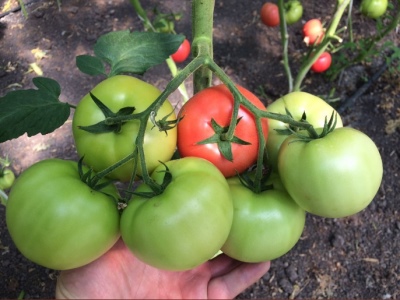
- Authors: Il Yong Kim (Monsanto Vegetable IP Management B.V.)
- Year of approval: 2017
- Name synonyms: Mei Shuai, Mei Shuai, Mei Shuay
- Category: hybrid
- Growth type: indeterminate
- Appointment: universal
- Ripening period: early
- Ripening time, days: 90-95
- Growing conditions: for film greenhouses, for greenhouses
- Marketability: high
Hybrid tomato Mei Shuai, also known as Mei Shuai, Mei Shuay, was developed by European experts for universal use. It is equally good as a salad base, and is also suitable for processing into mashed potatoes, ketchups, juices. Indeterminate hybrid perfectly adapted for greenhouse cultivation in different climatic zones.
Breeding history
The hybrid was bred by the breeder Il Yong Kim. The originator was the company from the Netherlands Monsanto Vegetable IP Management B. V. In the Russian Federation it was approved for use since 2017.
Description of the variety
Bushes are tall, strongly leafy. Moderate branching. The tops are green, formed from medium-sized, smooth, dark-colored leaves. Fruits are formed in whole clusters on strong and sturdy shoots, up to 7 per cluster. The standard for this hybrid is considered to be a height gain of about 2 m. The tomato has long internodes, intermediate inflorescences.
The main qualities of the fruit
The hybrid produces fruits of a flat-round shape with a slight ribbing of the edges. They are large, reaching a mass of 180-210 g, covered with a strong, shiny skin. In ripe tomatoes, it is pink, in unripe tomatoes it is green.
Taste characteristics
Ripe fruits have a sweet pleasant taste, the juicy pulp has no pronounced sourness or astringency. The sugar content of tomatoes is higher than in conventional varieties.
Ripening and fruiting
The variety is considered early. It takes 90-95 days to ripen.
Yield
With tomato harvest rates of 7.3-7.5 kg / sq. m this hybrid is usually referred to as high-yielding.
The timing of planting seedlings and planting in the ground
Plants will be ready for transfer to a permanent place in a greenhouse in late May - early June. In order for them to have time to grow by this time, the seeds are sown in 1-2 ten days of March. With an extended turnover, this happens even earlier, in January-February, with additional lighting and maintaining the temperature not lower than +27 degrees.

Growing tomato seedlings is an extremely important process, because it largely depends on whether the gardener will be able to harvest at all. All aspects must be taken into account, from seedbed preparation to planting in the ground.
Landing scheme
The standard recommended planting density is 2-3 plants per m2.

Growing and care
The bushes of this hybrid are formed into 2 stems. He also needs a garter to the trellis, since the climb is very intense. Grassing is done on a regular basis, as is the fight against excess leaves under the flower clusters. Mei Shuai is suitable for extended turnover cultivation in a foil greenhouse. Growing in this case is possible on special substrates or ordinary soils.
After being transferred to the greenhouse, the tomato bushes require acclimatization. Within 72 hours, the temperature inside the shelter is maintained at about +20 degrees, then it is increased during the day to +23, at night it is reduced to +17 Celsius. It is better to limit the growth of the stem when 5-6 clusters appear.It is also recommended to ration the ovaries so that the fruits are larger. No more than 4 tomatoes are left on each brush.
Plant nutrition is required already at the flowering stage of the first brushes. At this time, tomatoes need foliar irrigation with magnesium sulfate and iron in a chelated form. It will also be useful to use a combination of calcium nitrate and Agromaster fertilizer.




A plant needs different micronutrients at each stage of growth. All fertilizers can be divided into two groups: mineral and organic. Folk remedies are often used: iodine, yeast, bird droppings, eggshells.
It is important to observe the rate and period of feeding. This also applies to folk remedies and organic fertilizers.
Disease and pest resistance
The originator declares that the fruits are resistant to TMV, fusarium wilt, verticellosis and cladosporium disease. The hybrid is practically not affected by infections, but can be attacked by insect pests. It is also worth maintaining an optimal humidity regime in the greenhouse in order to avoid the spread of spores of fungal diseases. Mei Shuai has declared resistance to damage by the southern rootworm nematode.


Resistant to adverse weather conditions
The tomato hybrid is cold-resistant, and also tolerates extreme increases in atmospheric temperatures.
Review overview
According to summer residents, although Mei Shuai's pink tomatoes were initially targeted at the eastern market, they adapted quite well to Russian growing conditions. According to domestic gardeners, the hybrid is almost flawless in its characteristics. Fully ripe fruits do not have the main defect of poorly colored tomatoes - green shoulders.
The owners are delighted with the abundant fruiting, as well as the taste characteristics of the resulting crop. In addition, summer residents mention that the bushes practically do not suffer from the most common diseases of nightshade crops.
There are few shortcomings. Among them is the need for tall shoots for constant pinching. In addition, without pinching, the bushes can stretch up to 3 meters.

























































































